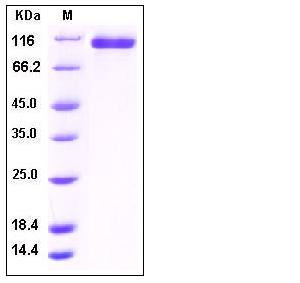Human Neuropilin-2 / NRP2 Protein (His Tag)
Neuropilin-2,NP2,NPN2,PRO2714,VEGF165R2
- 100ug (NPP4112) Please inquiry
| Catalog Number | P10695-H08H |
|---|---|
| Organism Species | Human |
| Host | Human Cells |
| Synonyms | Neuropilin-2,NP2,NPN2,PRO2714,VEGF165R2 |
| Molecular Weight | The recombinant human NRP2 consists of 844 amino acids and has a calculated molecular mass of 95 kDa. The apparent molecular mass of rhNRP2 is approximately 100-110 kDa in SDS-PAGE under reducing conditions due to glycosylation. |
| predicted N | Gln 23 |
| SDS-PAGE |  |
| Purity | > 97 % as determined by SDS-PAGE |
| Protein Construction | A DNA sequence encoding the extracellular domain (Met 1-Tyr 855) ofhuman Neurophilin2 isoform 2 (NP_003863.2) was expressed with a C-terminal polyhistidine tag. |
| Bio-activity | Measured by its binding ability in a functional ELISA. |
| Research Area | Immunology |Cytokines & Growth Factors |Growth Factor & Receptor |Vascular Endothelial Growth Factor (VEGF) & Receptor |VEGF Receptor |
| Formulation | Lyophilized from sterile PBS, pH 7.4 1. Normally 5 % - 8 % trehalose and mannitol are added as protectants before lyophilization. Specific concentrations are included in the hardcopy of COA. |
| Background | Neuropilin-2 (NRP-2) which is related to NRP-1, is a type I? transmembrane glycoprotein and has the structure characteristic with five main extracellular domains: two complement binding (CUB) domains, two coagulation factor V/VIII homology domains, and a MAM (meprin, tyrosine phosphatase domain) region. NRP-2 is a receptor capable of binding two disparate ligands, classⅢ semaphorins (SEMA) and vascular endothelial growth factors (VEGF), and thus regulates two diverse systems by activating cellular signaling pathways via interacting with other cell surface receptors such as VEGF receptors and plexins. NRP-2 is well known for its role in facilitating axonal guidance during the development of the neuronal system, and additionally, it is also expressed in vascular endothelial cells and lymphatic endothelium where it affects proliferation, migration, angiogenesis, as well as formation of small lymphatic vessels and capillaries. Recent study has identified NRP-2 as a polysialylated protein expressed in human dendritic cells and modulates DC-T cell Interactions. Nearly all tumor cells express neuropilins and NRP-2 is predominantly expressed in neuronal tumors and melanomas. Furthermore, it is suggested that as the specific ligand for NRP-2, SEMA 3F inhibits tumor angiogenesis and metastasis. |
| Reference |
